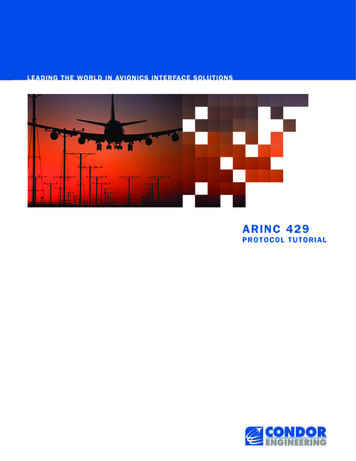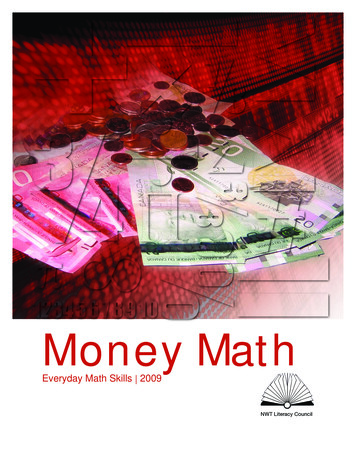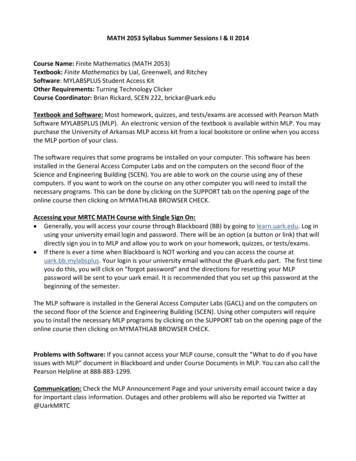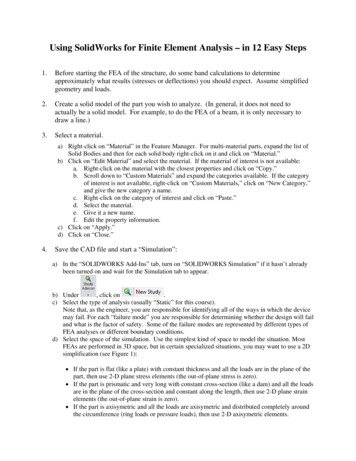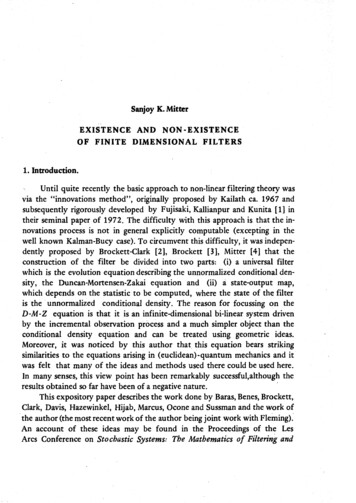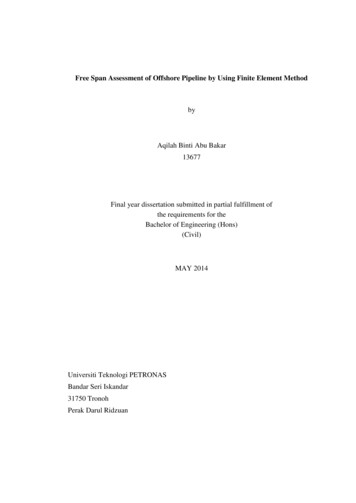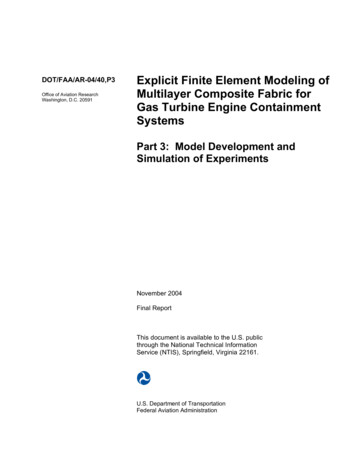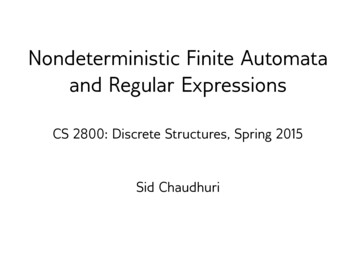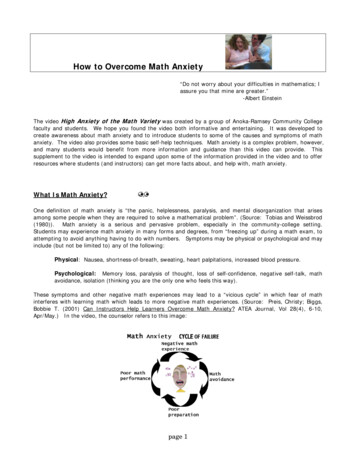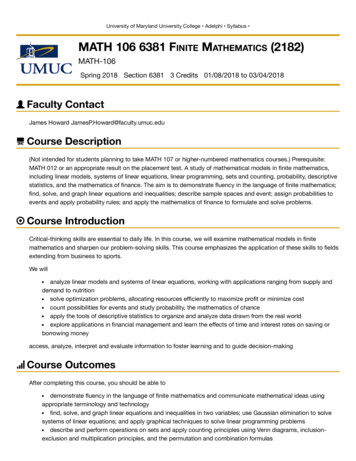
Transcription
University of Maryland University College Adelphi Syllabus MATH 106 6381 FINITE MATHEMATICS (2182)MATH-106Spring 2018 Section 6381 3 Credits 01/08/2018 to 03/04/2018Faculty ContactJames Howard JamesP.Howard@faculty.umuc.eduCourse Description(Not intended for students planning to take MATH 107 or higher-numbered mathematics courses.) Prerequisite:MATH 012 or an appropriate result on the placement test. A study of mathematical models in finite mathematics,including linear models, systems of linear equations, linear programming, sets and counting, probability, descriptivestatistics, and the mathematics of finance. The aim is to demonstrate fluency in the language of finite mathematics;find, solve, and graph linear equations and inequalities; describe sample spaces and event; assign probabilities toevents and apply probability rules; and apply the mathematics of finance to formulate and solve problems.Course IntroductionCritical-thinking skills are essential to daily life. In this course, we will examine mathematical models in finitemathematics and sharpen our problem-solving skills. This course emphasizes the application of these skills to fieldsextending from business to sports.We willanalyze linear models and systems of linear equations, working with applications ranging from supply anddemand to nutritionsolve optimization problems, allocating resources efficiently to maximize profit or minimize costcount possibilities for events and study probability, the mathematics of chanceapply the tools of descriptive statistics to organize and analyze data drawn from the real worldexplore applications in financial management and learn the effects of time and interest rates on saving orborrowing moneyaccess, analyze, interpret and evaluate information to foster learning and to guide decision-makingCourse OutcomesAfter completing this course, you should be able todemonstrate fluency in the language of finite mathematics and communicate mathematical ideas usingappropriate terminology and technologyfind, solve, and graph linear equations and inequalities in two variables; use Gaussian elimination to solvesystems of linear equations; and apply graphical techniques to solve linear programming problemsdescribe and perform operations on sets and apply counting principles using Venn diagrams, inclusionexclusion and multiplication principles, and the permutation and combination formulas
describe sample spaces and events, assign probabilities to events, and apply probability rules, includingthose for independent events, conditional probability, and discrete probability distributionsorganize, visually represent, and measure central tendency and variance of data, applying tools ofdescriptive statisticsapply the mathematics of finance to formulate and solve problems involving simple interest, compoundinterest, annuities, and amortized loansuse mathematical modeling to translate, solve, and interpret applied problems related to linear modeling,systems of linear equations, linear programming, counting, probability, statistics, and financeCourse MaterialsClick to access your course materials .cfm?C MATH%20106&S 6381&Sem 2182)Class GuidelinesWELCOME TO THE "NEW ACADEMIC MODEL" VERSION OF MATH 106 !Our Spring 2017 section of MATH 106 is the third "beta test" of this course format. Our section's classroom isconfigured to present you Finite Mathematics in the format of UMUC's "New Academic Model". This is acompetency-based education model where emphasis shifts from memorizing knowledge and preparing for examsto completing tasks that demonstrate mastery of competencies. Our class is designed around projects you willcomplete to demonstrate mastery of stated competencies. Some of the things you'll find "different" about thisclass:You are in charge of your learning! You have 8 weeks to complete the course, but how you do it and thepace at which you do it is up to you. There are still deadlines (see the "Course Schedule" section of thisSyllabus), but these are meant to keep you on track to master all the competencies you need to demonstrate tocomplete MATH 106.There are no single-attempt "quizzes" in this class; instead you perform graded "competency skillsreviews". Multiple attempts are allowed, so you can master the skills you need to complete MATH 106.The three "competency demonstration projects" are the major graded assessments. Once you submit theproject, you'll receive feedback and an opportunity to make revisions and resubmissions for better scores.But there's one thing you'll still find the same:There's a "comprehensive competency assessment" (Final Exam) at the end of the course!MATH 106 COMPETENCIESMATH 106 competencies are derived from UMUC "Learning Outcomes" for the course. They're grouped into threelevels:100 Level: Introduction to Fundamentals200 Level: Introduction to Competency Skills300 Level: Demonstration of CompetenciesEach level's tasks build on the tasks completed in previous levels. Here are the competencies you're expected tomaster in order to successfully complete MATH 106:CompetencyDescription
101Demonstrate fundamental knowledge of information found in coursesyllabus and fundamental ability to navigate LEO classroom201Demonstrate proficiency in formulating and solving mathematics offinance problems involving simple interest, compound interest,annuities, and amortized loans202Demonstrate proficiency in defining, solving, and graphing linearequations and inequalities in two variables203Demonstrate proficiency in defining and solving systems of linearequations and inequalities; and applying graphical techniques tosolve linear programming problems204Demonstrate proficiency in describing and performing operations onsets; and in applying counting principles using:Venn diagramscontingency tablesinclusion-exclusion and multiplication principles, andpermutation and combination formulas205Demonstrate proficiency in describing sample spaces and events,assigning probabilities to events, and applying probability rules,including those for:independent events,conditional probability, anddiscrete probability distributions206Demonstrate proficiency in organizing and visually representing data,numerically and graphically measuring relationship betweenresponses and frequency of responses, and in determining measuresof central tendency and variation of data in sets/samples/populations207Demonstrate proficiency in identifying normal data distribution and indetermining relationship between probability and measures of centraltendency and variation301Demonstrate mastery of "math of finance" competencies (201)through application of skills in completing a home-purchase projectusing fixed-rate mortgage loan financing302Demonstrate mastery of linear modeling and analysis competencies(202, 203, 204) through application of skills in completing a modeling& analysis project303Demonstrate mastery of probability, describing data, and introductionto statistics competencies (205, 206, 207) through application of skillsin completing a probability & statistics project
You'll see references made to these competencies and the individual skills you'll learn and apply throughout thiscourse.PREPARE TO GET STARTED!Within the Content section of your classroom, view the Start Here section to learn more about contacting facultyand to access the Classroom Walkthrough.To succeed in an 8-week mathematics course, it is important to complete all assignments on time. Print out a copyof the Course Schedule and keep it in a place where you can consult it daily.Log into our online classroom regularly to read news, participate in discussions, and post questions. After postingwork in a competency skills review or project, check back to read feedback and make any desired skills review reattempts or project resubmissions in order to improve score.Questions of general interest to the class should be posted in the “Have a Question?” discussion. For questionspertaining to your own work in the course, please send an e-mail with our course name in the subject line.Once you've gone through this syllabus and navigated around our LEO classroom, be sure to complete the Syllabus& Classroom Knowledge Assessment found in "Quizzes and Exams" under the My Tools link in our LEO classroom'sNavBar as soon as you can but before the end of Week 1! See "Grading Criteria" section of this syllabus for moreinfo on this assessment.Grading InformationYou are responsible for the following graded items:ComponentPercentageSyllabus & Classroom Knowledge Assessment4%Participation: Competency Skills Reviews (7 at 3% each)21%Loan Competency Demonstration Project20%Modeling & Analysis Competency Demonstration Project20%Probability & Statistics Competency Demonstration Project 20%Comprehensive Competency Assessment (Final Exam)15%Total100%To calculate your final course grade, you may use this formula: 0.04 x (percentage score on Syllabus & ClassroomKnowledge Assessment) 0.21 x (average of percentage scores on competency skills reviews) 0.20 x (loanproject percentage) 0.20 x (modeling & analysis project percentage) 0.20 x (statistics project percentage) 0.15x (comprehensive competency assessment/final exam percentage score).The work to do in this course consists ofweekly reading assignments (7) (ungraded)weekly homework assignments (7) (ungraded)syllabus & classroom knowledge assessment (graded)weekly competency skills review participation (7) (graded)
competency demonstration projects (3) (graded)Comprehensive competency assessment (final exam) (graded)These course components are described below.Weekly Reading Assignments (Ungraded)Even though there is no numerical score associated with the weekly reading assignments, how well you do in thecourse depends heavily on how conscientiously you follow the reading assignments.When doing the reading for this course, you need to slow down!Reading mathematics is not like reading anything else. You need to look carefully at the numbers and formulas andspend time making sure you understand them and that they make sense. Reading any mathematical text can takethree to four times longer, per page, than reading a non-mathematical text.Homework (Ungraded)There are ungraded homework assignments in each of the first seven weeks of class. The homework assignmentsgive you practice in solving problems associated with each week's topics. Your aim should be mastery of allconcepts, and you will be given opportunities to succeed in solving all of the problems every week. As completingthe homework problems on time will help you understand and master the topics, plan your weeks according to theschedule. Even though there is no numerical score associated with the weekly homework assignments, how wellyou do in the course depends on how conscientiously you do the homework assignments. During each of the firstseven weeks of class, there will be a selection of exercises available. See the Course Schedule for assignmentdates in each week.Syllabus & Classroom Knowledge AssessmentAn important competency in any workplace environment is understanding and acknowledging what is required tocomplete tasks. Your employer or supervisor informs you what is expected of you at work; this Course Syllabus isthe primary way your instructor informs you what’s expected of you in this course. You are responsible for readingand understanding all the information found in this Course Syllabus, and for completing the Syllabus & ClassroomKnowledge Assessment (found in "Quizzes and Exams" under the My Tools link in our LEO classroom) no later thanthe end of Week 1. This graded assessment can be taken multiple times up to the end of Week 1. It’s designed toget you to read and understand the Course Syllabus and to learn where to find things in our classroom - at thebeginning of class - so that the one thing you’ll never be able to say in this class is “I didn’t know what wasexpected of me”!Participation: Competency Skills ReviewsBy registering for a Web-based course, you have made a commitment to participate in course discussions andonline activities. Plan to participate regularly. Participation for this course is defined as proactive discussion andwork to learn & master competencies. This requires you to actively reflect on weekly readings, learn the competencyskills found in them, and demonstrate understanding of the competency skills. Where authorized, you areencouraged to respond to other students as well as to your instructor. You are expected to adhere to the generalrules of online etiquette.For individual participation on an ongoing basis, there are competency skills reviews for Weeks 1 through 7 postedin “Quizzes and Exams” under the My Tools link in our LEO classroom. These reviews are drawn primarily from theexercises in your OER (open e-resource) e-texts. You earn participation credit for Weeks 1 through 7 of the term bycompleting the competency skills review for each of these weeks.Competency skills reviews are open book, open-notes. The competency skills review for each week is posted in“Quizzes and Exams” under the My Tools link in our LEO classroom, with students’ initial submissions due at theend of that academic week. Competency skill review responses may be submitted with attached files such as
Microsoft Word documents, or with handwritten and scanned documents. For each competency skills review, youwill earn up to 100 participation points for the accuracy of your solutions. You’ll get feedback and the opportunityto attempt the review again for a better score. The goal of online participation in competency skills reviews is to helpyou learn & master the competency skills you’ll need to apply in completing the course projects.You may earn a total of 700 online participation points (7 reviews at 100 points each is the maximum for regularparticipation credit).At the end of the term, your total number of participation points will be multiplied by 1/7 to arrive at a percentage,and that score will count 21 percent toward your final grade. For instance, a total of 700 participation pointscorresponds to the participation percentage 700(1/7) 100%.Competency Demonstration ProjectsYou are required to complete three competency demonstration projects in this course in order to demonstratemastery of the competencies required to complete MATH 106. See the Competency Demonstration ProjectDescriptions section of the syllabus for details.Comprehensive Competency Assessment (Final Examination)All sections of this course have a required comprehensive competency assessment (the final examination),administered in a 72 hour period during Week 8, the last week of the course.The comprehensive competency assessment is “open-book”: you may use anything found in our LEO classroom tohelp you complete the assessment (including posted feedback and completed examples). The assessment consistsof multiple-choice and short answer questions. However, you are required to show your work and calculations,where requested, in order to receive full credit.The assessment must be individually completed and represent your own personal work. Collaboration orconsultation with others is not allowed. Use of any instructors' solutions manuals for any text or e-textis not allowed. Use of any online problem-solving service (Homework Raptor, Chegg, etc) is notallowed!Any evidence that a student even contacted or consulted an online problem-solving service SHALL result ina formal academic integrity violation charge being filed in accordance with UMUC Academic Policy 150.25.The solutions for the comprehensive competency assessment (final exam) will not be posted.You are expected to take the assessment as scheduled. In the event of illness or extraordinary circumstances, youmust contact your faculty member and provide documentation to request an exception and approval to take amakeup assessment. If the request is not approved, the assessment/exam grade will be recorded as a zero.Additional InformationLate PolicyOne workplace competency common to all professions is submitting required work on time. In order to provide youthe best opportunity to learn, understand, apply, get feedback, & master the competencies presented in MATH 106there are deadlines for initial submissions of the graded course deliverables. These deadlines are found in the“Class & Assignment Schedule” section of this Syllabus. Meeting course deadlines is crucial for success incomputer-mediated courses (whether hybrid or online-only). The following late policy applies to our MATH 106course deliverables:
Course DeliverableBest Grade You Can Get ifInitial Submission/Attempt is“ON TIME” (by or beforePublished Deadline)Best Grade You Can Get ifInitialSubmission/Attempt is“LATE” (after PublishedDeadline but before Endof tency SkillsReview (Weeks 1 -7)100 (A)CompetencyDemonstration Projects(re-attempts are allowed afterreceiving feedback so studentscan master skills and improvetheir score)79 (C)(re-attempts are allowedafter receiving feedback sostudents can improve theirscore, but best gradepossible is 79)100 (A)(edits & resubmissions areallowed after receiving feedbackso students can mastercompetencies and improve theirscore)ComprehensiveCompetency100 (A)Assessment (Final Exam)75 (C)(edits & resubmissions areallowed after receivingfeedback so students canimprove their score, butbest grade possible is 75)0 (F)(published deadline IS endof course!)If an emergency situation occurs or a valid reason exists which results in you being unable to submit a coursedeliverable by the published deadline, I will give consideration to extension requests made BEFORE thedeliverable’s deadline only!Guideline for Receiving Tutoring ServicesWe appreciate that many students may seek tutoring services to supplement our instructional program. However,tutors may not be used to complete any portion of assignments, projects, quizzes, and exams on behalf ofstudents. Students are expected to submit their own work. Students who are suspected of submitting the work oftheir tutors will be reported to the dean's office for potential investigation.If you are to receive tutoring services, inform your tutor of this expectation and clarify your tutor's role andresponsibility to your academic endeavors at UMUC.
Project DescriptionsYou are required to complete three competency demonstration projects to complete this course:Loan Project: Buying a HouseFor this assignment, you will analyze a home mortgage loan. In our LEO classroom, navigate Content Competency Demonstration Projects Loan Competency Demonstration Project for detailed instructions.Modeling & Analysis ProjectFor this project, you will:model a real-world organizational, business, or technical process using past and present datause that model to predict future performance of the processdetermine what process input values will optimize the processIn our LEO classroom, navigate Content Competency Demonstration Projects Modeling & AnalysisCompetency Demonstration Project for detailed instructions.Probability & Statistics ProjectFor this assignment, you will implement a project involving probability determination, expected value, and datadescription using basic statistical procedures. The topic may be something that is related to your work, a hobby, orsomething you found interesting. In our classroom, navigate Content Competency Demonstration Projects Probability & Statistics Competency Demonstration Project for detailed instructions.Academic PoliciesAcademic Policies and GuidelinesACADEMIC INTEGRITYAs a member of the University of Maryland University College (UMUC) academic community that honors integrityand respect for others you are expected to maintain a high level of personal integrity in your academic work at alltimes. Your work should be original and must not be reused in other courses.CLASSROOM CIVILITYStudents are expected to work together cooperatively, and treat f
configured to present you Finite Mathematics in the format of UMUC's "New Academic Model". This is a competency-based education model where emphasis shifts from memorizing knowledge and preparing fo
